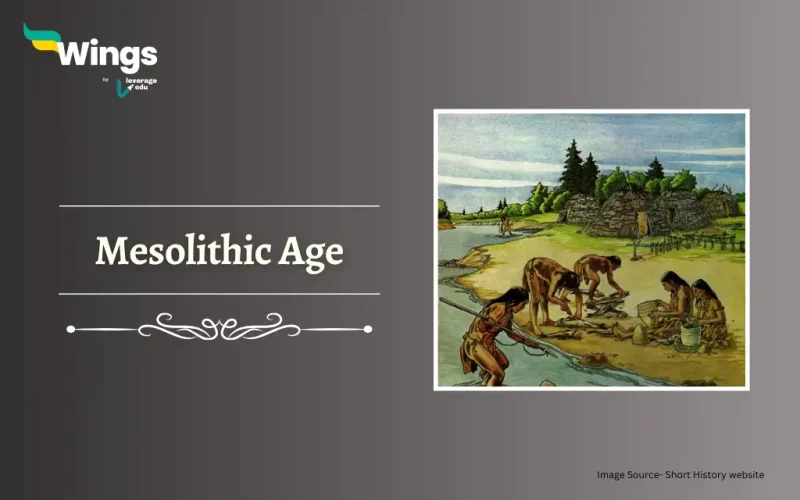The Mesolithic Age or the Middle Stone Age saw major developments not only in terms of stone tools but also in growing civilizations. Even though humans were still hunters and gatherers, they discovered the power of teaming up by killing large animals in herds. After the Palaeolithic age when humans evolved in behaviour to differentiate themselves from animals, came the age to become people of the settlements. Furthermore, they even began practising farming activities which reduced the nomadic culture. Many more features of the Mesolithic age are discussed in this blog below, read through to know more!
Mesolithic Age
The end of the Palaeolithic age marked the beginning of the Mesolithic age of humans. In 1866, Hodder Westropp was the one to include the Mesolithic age between the Palaeolithic and Neolithic. Earlier it was only the Palaeolithic and Neolithic ages, but later this change was made to differentiate the great period. Moreover, to study its features differently as they existed in a separate transition periods, the Neolithic age came into existence.
Also Read: Indus Valley Civilization: Time-Period, Culture & Excavation Sites
What Happened during the Mesolithic Age?
In the Palaeolithic era, life revolved around hunting and gathering. However, the Mesolithic Age marked a shift with the development of agriculture.
- Agriculture allowed permanent settlements to arise, as people no longer needed to always hunt for food for sustenance.
- In addition, despite the rise of agriculture, hunting still was a significant activity during the Mesolithic Age.
- Settlements during this time varied from simple villages of huts to more complex walled cities.
Also Read: A Complete Roadmap to the Discovery of Fire
When Did the Mesolithic Age Begin?
In India, the Mesolithic age continued from 9000 B.C to 4000 B.C. However, the Age began at different times in different parts of the world based on the speed of development of people there. Here is a description of the beginning of the Mesolithic age around the world.
| The Timeline of the Mesolithic Age Around the World | |
| Region | Timeline of the Mesolithic Age |
| Western Europe | 14,000 years ago |
| Europe | 11,500 |
| Balkans | 15,000 |

Did You Know? Dogs were First Domesticated during the Mesolithic Age.
Mesolithic Archaeological Sites Discovered in India
Here is a list of the Mesolithic archaeological sites that were discovered in India. Some of these sites showed signs of living in colonies and making houses. The excavations also revealed that the major occupation of the people was agriculture and animal husbandry.
| Mesolithic Archaeological Sites Discovered in India | |
| Region | Mesolithic Archaeological Sites in India |
| Rajasthan | Bagor |
| Gujarat | Langhnaj |
| Mirzapur, Uttar Pradesh | Mohrana Pahara |
| Madhya Pradesh | Bhimbetka |
| Madhya Pradesh | Adamgarh |
Also Read: Types of Vedas: Important Features & Details
Mesolithic Age Tools: Microlith, the Invention
By this time, humans had smaller stone-chipped tools rather than only large tools. This was a result of learning to grind the stone better. Earlier, the pebbles were rubbed across one another to get a spear-shaped head of the tool and a rounded bottom.
- These Microliths were the most used tools of that time.
- They had point tools to make spears, stone awls to poke holes in animal hides and scrapers to chip wood and carve objects.

The Mesolithic Art
The Mesolithic art is more about the changing lifestyle and climate during that period. It involves rock paintings, cave paintings and clay crafts. Most of the rock paintings were found in western Spain but many sites in Asia, Africa, Australasia, and America also had such paintings.
- The paintings were also not anymore about the animals and other basic things but about the art and interaction of humans.
- However, the cave paintings did not die either but the subject was changed there as well.
- Humans also started to use clay for making bracelets necklaces and other decorative items.
- They were also good at pottery and used ceramic designs to decorate their artwork. Many countries have evidence of such pottery.

Who is the Cheddar Man?
Cheddar Man, a Mesolithic individual, lived around 10,000 years ago in what is now the Cheddar Gorge in Somerset, England.
- In 1903, his remains were discovered in Gough’s Cave, offering a remarkable glimpse into prehistoric life.
- Analyses of his skeletal remains and DNA reveal intriguing details.
- He was around 5’5″ tall, had a robust build, and likely lived a challenging but adaptable hunter-gatherer lifestyle.
- Most notably, DNA analysis in 2018 revealed that Cheddar Man had dark to black skin, blue eyes, and dark, curly hair, challenging previous assumptions about ancient Britons’ appearance.
- This discovery shed light on the diverse and complex nature of early European populations, highlighting the migration patterns and genetic adaptations of ancient peoples.
- Thus, the Cheddar Man’s story provides a tangible link to our ancient past, hence enriching our understanding of human history in the British Isles and beyond.

Relevant Blogs
| Palaeolithic Age | Stone Age Tools |
| Major Climate Change after Ice Age | Arab Nationalism |
| All The Names of India Throughout History | Tribes of India |
| Gupta Empire | Post Mauryan Period |
This was all about the history, artefacts and developments around the Mesolithic age. If you want to learn more about such historical topics, you can find more informative blogs on Indian History by staying tuned to our General Knowledge section.
 One app for all your study abroad needs
One app for all your study abroad needs













